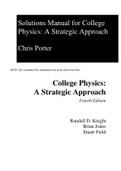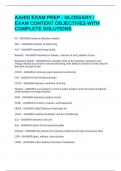College Physics: A Strategic Approach Fourth Edition Randall D. Knight Brian Jones Stuart Field Solutions Manual for College Physics: A Strategic Approach Chris Porter
NOTE: (For Complete File, Download Link at the end of this File) © Copyright 2019 Pearson Education, Inc. All rights reserved. This material is protected under all copyright laws as they currently exist. No portion of this material may be reproduced, in any form or by any means, without permission in writing from the publisher. 1-1 Q1.1. Reason: The softball player starts with an initial velocity but as he slides he moves slower and slower until coming to rest at the base. The distance he travels in successive times will become smaller and smaller until he comes to a stop. See the figure below. Assess: Compare to Figure 1.10 in the text. Q1.2. Reason: Assess: The dots are equally spaced until the brakes are applied to the car. Equidistant dots indicate constant average speed. On braking, the do ts get closer as the average speed decreases. Q1.3. Reason: REPRESENTING MOTION 1 1-2 Chapter 1 © Copyright 201 9 Pearson Education, Inc. All rights reserved. This material is protected under all copyright laws as they currently exist. No portion of this material may be reproduced, in any form or by any means, without permission in writing from the publisher. Assess: The spacing between dots is initially large, since the initial speed with which the bush baby leaves the ground is large. As the bush baby rises and gravity slows the ascent, the spe ed decreases and therefore the spacing between adjacent dots in the motion diagram decreases. Q1.4 . Reason: As the ball drops from the tall building t 02.he ball will go faster and faster the farther it falls under the pull of gravity. The motion diagram should show the displacements for later times to be getting larger and larger. The successive displacements in the diagram given in the text get smaller and smaller. So the diagram given in the problem is incorrect. The correct diagram is below. Asse ss: Compare to Figure 1.5 in the text, which shows a motion diagram for two objects falling under the influence of gravity. The displacements increase during the fall of the object as we reasoned. Q1.5 . Reason: Position refers to a location in a coordin ate frame. A displacement is the difference between two positions. In general, displacement is a vector and requires a direction. But in this one -dimensional case, we ignore that subtlety. The four miles Mark and Sofia walked definitely refer to a differen ce between their starting and ending positions. There is no information given about a reference frame. So it is more reasonable to associate the four miles with a displacement (magnitude) than with an absolute position. Assess: Mark and Sofia’s position c ould be specified as (for example) 100 m west of a particular intersection. But what is described is a difference between two positions. This is more like a displacement magnitude. Note that if their starting point had been the origin of a coordinate syste m, then both Mark and Sofia would be correct. Q1.6. Reason: The distance you travel will be recorded on the odometer. As you travel, the distance you travel accumulates, is recorded by the odometer, and is independent of the direction of travel. Your dis placement is the difference between your final position and your initial position. If you travel around a 440 m track and end up where you started, you have traveled 440 m; however, since you ended up where you started, your change in position and hence di splacement is zero. Assess: If you watch a track meet, you will observe the 440 -m race. As you watch the race, it is obvious that the runners travel a distance of 440 m (assuming they complete the race). Yet since they end up where they started, their final position is the same as their initial position and hence their displacement is zero. Q1.7 . Reason: Both speed and velocity are ratios with a time interval in the denominator, but speed is a scalar because it is the ratio of the scalar distance over th e time interval while velocity is a vector because it is the ratio of the vector displacement over the time interval. Speed and velocity have the same SI units, but one must specify the direction when giving a velocity. An example of speed would be that yo ur hair grows (the end of a strand of hair moves relative to your scalp) at a speed of about 0.75 in/month. An example of velocity (where direction matters) would be when you spring off a diving board. Your velocity could initially be 2.0 m/s up, while lat er it could be 2.0 m/s down. Representing Motion 1-3 © Copyri ght 201 9 Pearson Education, Inc. All rights reserved. This material is protected under all copyright laws as they currently exist. No portion of this material may be reproduced, in any form or by any means, without permission in writing from the publisher. Assess: Saying that a velocity has both magnitude and direction does not mean that velocity is somehow “better” and that speeds are never useful. Sometimes the direction is unimportant and the concept of speed is useful. In ot her cases, the direction is important to the physics, and velocity should be cited. Each shows up in various physics equations. Q1.8 . Reason: Since the velocity of the skateboard is negative during the whole time of its motion, it is moving in the negati ve direction the entire 5 seconds. In order to move closer to the origin, which is in the positive direction relative to the starting point of the skateboard, the skateboard must have had a velocity in the positive direction for some time. Since the veloci ty is always negative, the skateboard must be farther from the origin than initially. Assess: Velocity gives direction of motion since it refers to displacements and not only distance traveled. If velocity is always negative, displacement will be negativ e also. Q1.9 . Reason: If the position of the bicycle is negative it is to your left . The bicycle’s velocity is positive, or to the right, so the bicycle is getting closer to you. Assess: If the initial position had been positive and the velocity positi ve, the bicycle would be getting farther away from you. Q1.10 . Reason: Since the jogger is running around a track, she returns to her starting point at the end of the lap. Since her final position is the same as her initial position, her displacement is 0 m. Velocity is defined as displacement in a given time intervalvelocitytime interval= So her average velocity is 0 m/s! However, though her displacement is 0 m, the actual distance she traveled is 400 m. Her average speed is not zero, since speed is defined in terms of distance, not d isplacement. distance traveled in a given time interv alspeedtime interval= Her average speed is then
400 m
100 s4 m/s= The second friend is correct. Since the motion of a runner is not uniform we can only calculate average velocity and average speed. Assess: This problem illustr ates a very important difference between speed and velocity. Speed depends on total distance traveled. Velocity depends on displacement, which only takes into account the starting and ending points of a motion. Q1.11. Reason: Assess: The dots get farther apart and the velocity arrows get longer as she speeds up. Q1.12 . Reason: The child will be traveling with a constant velocity until hitting the rocky patch. During the constant velocity part of the motion the motion diagram should show equal dis placements during each time interval. After hitting the rocky patch, the sled will start slowing. After this point the motion diagram should show ever -
decreasing displacements and ever -decreasing velocity vectors. The motion diagram is below. Assess: Compare to Figure 1.11 in the text where a similar motion is illustrated.





